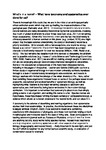What's in a name? What have taxonomy and systematics ever done for us?
| dc.contributor.author | Bilton, David | |
| dc.date.accessioned | 2018-08-13T13:38:18Z | |
| dc.date.available | 2018-08-13T13:38:18Z | |
| dc.date.issued | 2014-09 | |
| dc.identifier.issn | 0021-9266 | |
| dc.identifier.issn | 2157-6009 | |
| dc.identifier.uri | http://hdl.handle.net/10026.1/12067 | |
| dc.description.abstract |
There is increasingly little doubt that we are in the midst of an anthropogenically driven extinction event which may end up rivalling the mass extinctions of the geological past (Barnosky et al., 2011). Increasingly the world’s natural and seminatural habitats are being irreversibly transformed by human populations, meaning that much of global biodiversity is under threat (see Caro et al., 2011 on remaining intact ecosystems). Given this “biodiversity crisis” and the fact that biodiversity is ultimately essential to human survival on this planet (e.g. Juniper, 2013) one might expect that the basic science underpinning the study of biodiversity would be a priority worldwide. Unfortunately, with a few exceptions, one would be wrong – and indeed a so-called “Taxonomic Impediment” has been recognized as a major obstacle to biodiversity research for over two decades (Wilson, 1988; Riedel et al., 2013). The fact remains that despite much time devoted to discussing the problem and its possible solutions (e.g. House of Lords Science and Technology Committee 1992, 2008; Deans et al., 2011) we are still not training enough people in taxonomy, nor are we employing enough taxonomically-orientated biologists in universities. Some of the educational consequences of this have been discussed before, including in the pages of this journal. Leather and Quicke (2009) point out how a limited study of organismal biology in many modern university curricula translates through to a lack of natural history knowledge in schoolchildren, as it results in biology teachers with limited knowledge of the wider diversity of life. Here, rather than revisiting these arguments I instead focus on some of the perhaps lesser-known academic, educational and societal benefits of systematic biology, as well as highlighting what I believe is the major remaining obstacle to taxonomy and systematics, and their benefits, being better embedded in the modern biology curriculum. It is important to remember that taxonomy is about more than simply giving a name to an organism, and adding this name to a list. Species names are hypotheses, these hypotheses forming the basic currency of comparative biology, a science which allows us to better understand the natural world, and our place in it. | |
| dc.format.extent | 116-118 | |
| dc.language | en | |
| dc.language.iso | en | |
| dc.publisher | Informa UK Limited | |
| dc.title | What's in a name? What have taxonomy and systematics ever done for us? | |
| dc.type | journal-article | |
| dc.type | Review | |
| dc.type | Journal | |
| plymouth.author-url | http://gateway.webofknowledge.com/gateway/Gateway.cgi?GWVersion=2&SrcApp=PARTNER_APP&SrcAuth=LinksAMR&KeyUT=WOS:000337964200002&DestLinkType=FullRecord&DestApp=ALL_WOS&UsrCustomerID=11bb513d99f797142bcfeffcc58ea008 | |
| plymouth.issue | 3 | |
| plymouth.volume | 48 | |
| plymouth.publication-status | Published | |
| plymouth.journal | JOURNAL OF BIOLOGICAL EDUCATION | |
| dc.identifier.doi | 10.1080/00219266.2014.926653 | |
| plymouth.organisational-group | /Plymouth | |
| plymouth.organisational-group | /Plymouth/Faculty of Science and Engineering | |
| plymouth.organisational-group | /Plymouth/Faculty of Science and Engineering/School of Biological and Marine Sciences | |
| plymouth.organisational-group | /Plymouth/REF 2021 Researchers by UoA | |
| plymouth.organisational-group | /Plymouth/REF 2021 Researchers by UoA/UoA07 Earth Systems and Environmental Sciences | |
| plymouth.organisational-group | /Plymouth/Research Groups | |
| plymouth.organisational-group | /Plymouth/Research Groups/Marine Institute | |
| plymouth.organisational-group | /Plymouth/Users by role | |
| plymouth.organisational-group | /Plymouth/Users by role/Academics | |
| dcterms.dateAccepted | 2014-05-01 | |
| dc.identifier.eissn | 2157-6009 | |
| dc.rights.embargoperiod | Not known | |
| rioxxterms.versionofrecord | 10.1080/00219266.2014.926653 | |
| rioxxterms.licenseref.uri | http://www.rioxx.net/licenses/all-rights-reserved | |
| rioxxterms.licenseref.startdate | 2014-09 | |
| rioxxterms.type | Journal Article/Review |


